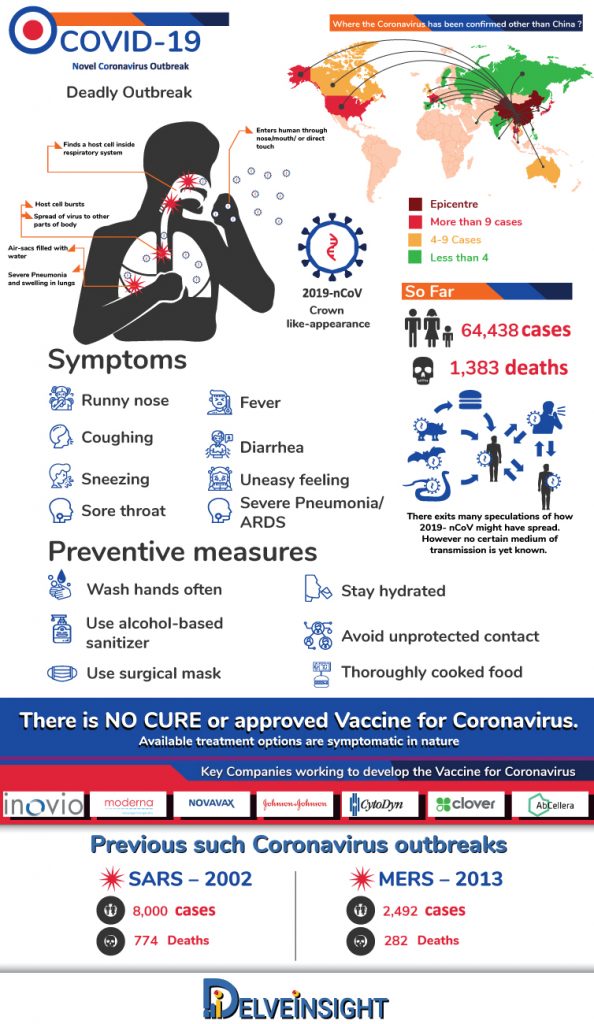Wuhan Coronavirus: A global emergency
Jan 31, 2020
Table of Contents
An outbreak of a mysterious viral infection, 2019-nCoV – coronavirus, has set the whole world on toes, claiming the lives of more than 800 people in China, surpassing the death toll caused from SARS, reports the Chinese government. An infection with the symptoms more or less like pneumonia, known by the name ‘Coronavirus’, dates back to 1960s, has now again made its re-entry in the city, Wuhan in China. Besides China, thirteen other countries have confirmed positive cases of a novel coronavirus, with the toll of infected people at 40,554 globally, and deaths 910, the cases, as well as deaths due to the Coronavirus, are likely to rise in coming days until the outbreak ceases.
What is Coronavirus?
A coronavirus is a family of common viruses that causes a multitude of respiratory illnesses and infection in nose, throat, and sinuses, symptoms often of a common cold. The virus derives its name from its crown like-appearance, due to being enveloped by a protein, under the microscope.
Downloads
Article in PDF
Recent Articles
- Notizia
- Gilead’s remdesivir trials; F2G raises $60.8M; Cancer immunotherapy research updates; Celle...
- Hepatitis C drugs re-energize global fight over patents
- Artios collaborates with Novartis; Scholar Rock eyes Phase III trial; Novavax starts crossover ar...
- Gilead’s Magrolimab Plus Azacitidine for MDS; FDA Approveds VANFLYTA for Newly Diagnosed AML; FDA...
The coronavirus has often been compared with that of infections due to SARS and MERS. However, most coronaviruses are not that deadly. There are four major subtypes of Coronavirus so far detected, known as alpha, beta, gamma, and delta.
The most common cold is a result of human coronaviruses; however, sometimes coronaviruses that affect animals also possess the capability to evolve to afflict human beings. Not so long back, outbreak of Severe acute respiratory syndrome (SARS), in more than ten countries in North America, South America, Europe, and Asia, and later in 2012 Middle East Respiratory Syndrome (MERS) in Saudi Arabia and other several countries, including the United States had put the scientist and authorities all over the world on high alert.
The SARS outbreak in 2002-2003 was the first global pandemic of the 21st century, has affected more than 20,626 people with 427 deaths. Similar was the case with Middle East Respiratory Syndrome (MERS-CoV), was first reported in Saudi Arabia, has 2494 laboratory-confirmed cases claiming the lives of approximately 282 people.
How is the Coronavirus transmitted?
The coronavirus is transmitted the same way other common cold viruses spread, i.e., the air contaminated by sneezing and coughing out viral particles by an infected person, through close personal contact, and faecal contamination.
Scientists say infection from coronavirus is widespread. Almost everyone gets the infection once in her lifetime, however most likely in younger age.
Interestingly enough, the epidemic of coronavirus has been linked to seafood and animal market in Hubei province in Wuhan city. However, emerging rapidly diagnosed cases of coronaviruses depicts a human-to-human spread, in addition to animal-to-human.
At the moment, the authorities are uncertain of the exact cause of the spread of coronavirus.
Many countries, in order to keep the epidemic of coronavirus at bay, are taking many preventive measures, such as screening of travellers at high temperatures with thermal imaging, and China has even restricted travelling to/from Wuhan placing it under quarantine. The coincidence of the outbreak with the most important and long festive season of China has also aided and abetted the spread of the coronavirus.
Who all are at risk
The first patient, whose life coronavirus 2019-nCoV took, was an old man aged 61 and had severe pneumonia. The second patient was also an old person, aged 69. Besides their age, a common trait that both the patients expressed was they both were long-term smokers rendering their lungs vulnerable to coronavirus attack. The lungs failed to provide enough oxygen and the heart failed to function properly.
Moreover, a survey of 99 patients being treated at the epicentre of the disease, revealed that most of the patients were middle-aged, men and had other long-term diseases that made them more prone to virus attack. However, the China Centers for Disease Control and Prevention said 1.2 men were infected for every 1.0 women, indicating a more even gender split. Scientists are saying that an extra X chromosome might be guarding females as a possible explanation.
However, it is to note that the viral attack is severe in the case of people with compromised immunity.
Tracking the spread
The sickening Wuhan coronavirus has invaded at least sixteen countries, with more than 100 confirmed cases, but no deaths so far, since the first case was confirmed.
At least fourteen cases in Thailand, eleven in Japan, ten each in Hong Kong and Singapore, seven in Australia, five in Singapore, USA, and Taiwan, and one in India cases have been confirmed for Coronavirus. In addition to this, governments in Nepal, Canada, Cambodia, Vietnam, France, South Korea, Malaysia, Sri and Lanka have also reported patients testing positive for the virus.
Researchers at North-eastern University and Imperial College London reports the number of the estimated coronavirus cases may be a far cry from the actual number of the cases, due to misdiagnosis, underdiagnosis or pending confirmed status of the virus. They estimate that the real figure would be five to ten times higher than the reported one based on analysing the population of Wuhan, the number of cases detected outside of China and the number of travellers to/from Wuhan.

Work on finding a vaccine continues apace
At the moment, there is no cure for coronavirus. With nothing at hand, the best method undertaken to limit the epidemic of coronavirus is to isolate the infected people and prevent human-to-human spread. However, efforts, all over the world, are underway to find a standard cure for coronavirus.
Recently, the companies namely Inovio Pharmaceuticals, Moderna, and Novavax were in news too. The shares of the companies surged as they received the grant, worth USD 11 Million by the Coalition for Epidemic Preparedness Innovations, a public-private Norway-based non-profit organization. The proceeds, companies plan to use to kill the Wuhan strain of coronavirus. The University of Queensland in Australia is also among those, which is working to find a cure.
Companies, including Johnson and Johnson (J&J), CytoDyn, Clover and AbCellera have also started their work to develop vaccines and treatments for the new coronavirus infection. Pharmaceutical company, J&J, is utilizing technology from its unit Janssen Pharmaceutical to facilitate the development of a vaccine against the Wuhan coronavirus. On a similar note, a biotech company, CytoDyn, is testing its drug leronlimab in combination with other drugs in a hope to find a cure for Coronavirus.
Similarly, Clover biopharmaceutical is manufacturing a recombinant subunit vaccine to tackle the virus by leveraging its Trimmer-Tag technology. AbCellera, on the other hand, would take help from its pandemic response platform, to identify the antibodies and target the virus.
With three clinical trials in running, the vaccines, the pharma companies are working on, might be ready for human testing; however, the avenue of achieving the standard cure is far away.
Gilead’s drug, Remdesivir, an antiviral medication, which was manufactured to tackle viral infections like SARS, and Ebola, has now been tested on patients with Coronavirus, in Wuhan. For the very first time, the drug was administered to a 35-year old US patient, tested positive for 2019-nCoV. The drug helped in improving pneumonia within a day, without causing any side effects.
To battle the novel Wuhan Coronavirus, and due to the lack of available standard treatments, pharma companies are trying their best to find a way to cure and prevent it from spreading further. Their inherent ability to mutate at a much faster rate makes the case worse.
Downloads
Article in PDF
Recent Articles
- Booming Healthcare sector in MENA: Lucrative opportunity for Global pharma players
- Remdesivir accelerates for COVID-19 recovery; Merck pact with Almac; Pfizer, BioNTech finish dosi...
- Notizia
- Ethicon’s ETHIZIA Hemostatic Sealing Patch; FDA Approves Medtronic’s Minimally Invasive Device to...
- Digital Pill: A new frontier in digital healthcare all set to take-off



